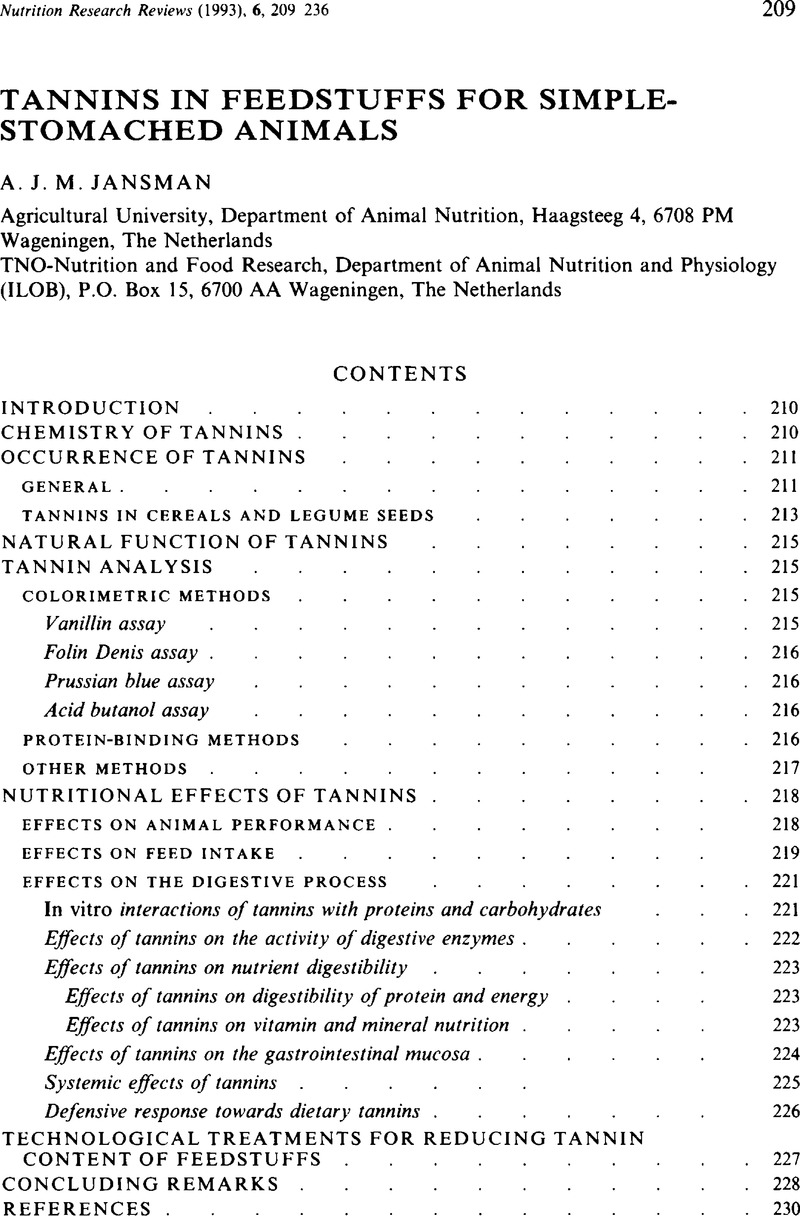Crossref Citations
This article has been cited by the following publications. This list is generated based on data provided by Crossref.
Jansman, A.J.M.
Verstegen, M.W.A.
and
Huisman, J.
1993.
Effects of dietary inclusion of hulls of faba beans (Vicia faba L.) with a low and high content of condensed tannins on digestion and some physiological parameters in piglets.
Animal Feed Science and Technology,
Vol. 43,
Issue. 3-4,
p.
239.
Jansman, Alfons JM
Frohlich, Andrew A
and
Marquardt, Ronald R
1994.
Production of Proline-Rich Proteins by the Parotid Glands of Rats Is Enhanced by Feeding Diets Containing Tannins from Faba Beans (Vicia faba L.).
The Journal of Nutrition,
Vol. 124,
Issue. 2,
p.
249.
Duc, G.
Brun, N.
Merghem, R.
and
Jay, M.
1995.
Genetic variation in tannin‐related characters of faba‐bean seeds (Vicia faba L.) and their relationship to seed‐coat colour.
Plant Breeding,
Vol. 114,
Issue. 3,
p.
272.
Nyachoti, C.M.
Atkinson, J.L.
and
Leeson, S.
1996.
Response of Broiler Chicks Fed a High-Tannin Sorghum Diet.
Journal of Applied Poultry Research,
Vol. 5,
Issue. 3,
p.
239.
Wang, Z. S.
Goetsch, A. L.
Park, K. K.
Patil, A. R.
Kouakou, B.
Galloway, D. L.
and
Rossi, J. E.
1996.
Addition of Condensed Tannin Sources to Broiler Litter Before Deep-Stacking.
Journal of Applied Animal Research,
Vol. 10,
Issue. 1,
p.
59.
Yu, Feng
Moughan, P. J.
and
Barry, T. N.
1996.
The effect of cottonseed condensed tannins on the ileal digestibility of amino acids in casein and cottonseed kernel.
British Journal of Nutrition,
Vol. 75,
Issue. 5,
p.
683.
Nyachoti, C.M.
Atkinson, J.L.
and
Leeson, S.
1997.
Sorghum tannins: a review.
World's Poultry Science Journal,
Vol. 53,
Issue. 1,
p.
5.
Dawson, Janet M
Buttery, Peter J
Jenkins, David
Wood, Christopher D
and
Gill, Margaret
1999.
Effects of dietary quebracho tannin on nutrient utilisation and tissue metabolism in sheep and rats.
Journal of the Science of Food and Agriculture,
Vol. 79,
Issue. 11,
p.
1423.
van Barneveld, R. J.
Edwards, A. C.
and
Huisman, J.
2000.
Linking Research and Marketing Opportunities for Pulses in the 21st Century.
Vol. 34,
Issue. ,
p.
661.
Nyamambi, Bethule
Ndlovu, Lindela R
Read, John S
and
Reed, Jess D
2000.
The effects of sorghum proanthocyanidins on digestive enzyme activityin vitro and in the digestive tract of chicken.
Journal of the Science of Food and Agriculture,
Vol. 80,
Issue. 15,
p.
2223.
Nyachoti, Charles
Gabert, Vincent
and
Jørgensen, Henry
2000.
Swine Nutrition, Second Edition.
Bartolomé, B.
Estrella, I.
and
Hernández, M.T.
2000.
Interaction of Low Molecular Weight Phenolics with Proteins (BSA).
Journal of Food Science,
Vol. 65,
Issue. 4,
p.
617.
van Heugten, Eric
2000.
Swine Nutrition, Second Edition.
McSweeney, C.S.
Palmer, B.
Bunch, R.
and
Krause, D.O.
2001.
Effect of the tropical forage calliandra on microbial protein synthesis and ecology in the rumen.
Journal of Applied Microbiology,
Vol. 90,
Issue. 1,
p.
78.
Juskiewicz, J.
Wróblewska, M.
Zhaki, K.
Zdunczyk, Z.
and
Hussein, L.
2001.
BIOLOGICAL ACTIVITY OF FABA BEANS PROANTHOCYANIDINS.
Acta Alimentaria,
Vol. 30,
Issue. 1,
p.
63.
Abia, Rocío
and
Fry, Stephen C
2001.
Degradation and metabolism of 14C‐labelled proanthocyanidins from carob (Ceratonia siliqua) pods in the gastrointestinal tract of the rat.
Journal of the Science of Food and Agriculture,
Vol. 81,
Issue. 12,
p.
1156.
McSweeney, C.S
Palmer, B
McNeill, D.M
and
Krause, D.O
2001.
Microbial interactions with tannins: nutritional consequences for ruminants.
Animal Feed Science and Technology,
Vol. 91,
Issue. 1-2,
p.
83.
Marzo, F.
Urdaneta, E.
and
Santidrián, S
2002.
Liver Proteolytic Activity in Tannic Acid-Fed Birds.
Poultry Science,
Vol. 81,
Issue. 1,
p.
92.
Echeverrı́a, V
Belmar, R
Ly, J
and
Santos-Ricalde, R.H
2002.
Effect of Leucaena leucocephala leaf meal treated with acetic acid or sodium hydroxide on apparent digestibility and nitrogen retention in pig diets.
Animal Feed Science and Technology,
Vol. 101,
Issue. 1-4,
p.
151.
Nieto, R
Rivera, M
Garcı́a, Ma.A
and
Aguilera, J.F
2002.
Amino acid availability and energy value of acorn in the Iberian pig.
Livestock Production Science,
Vol. 77,
Issue. 2-3,
p.
227.





